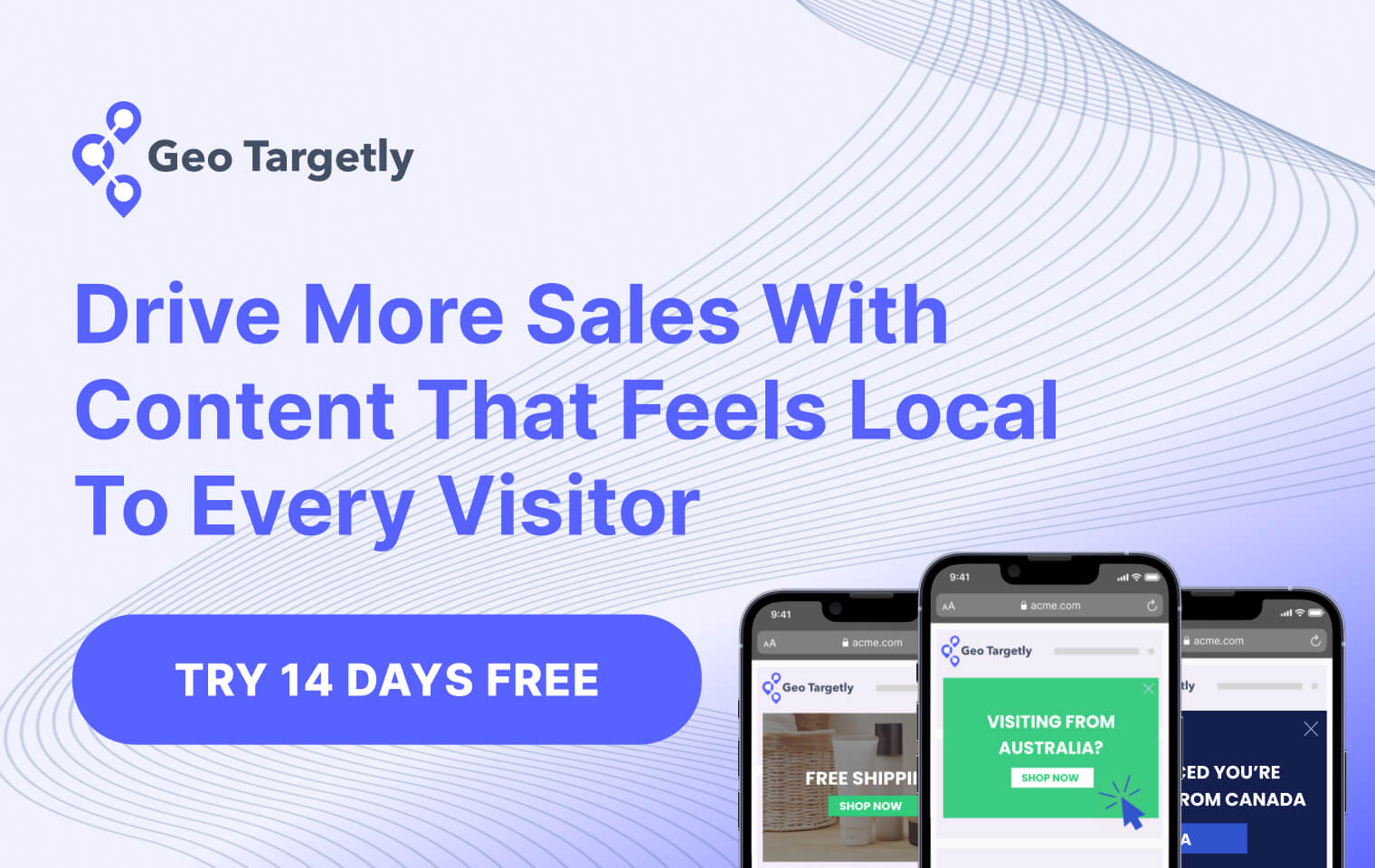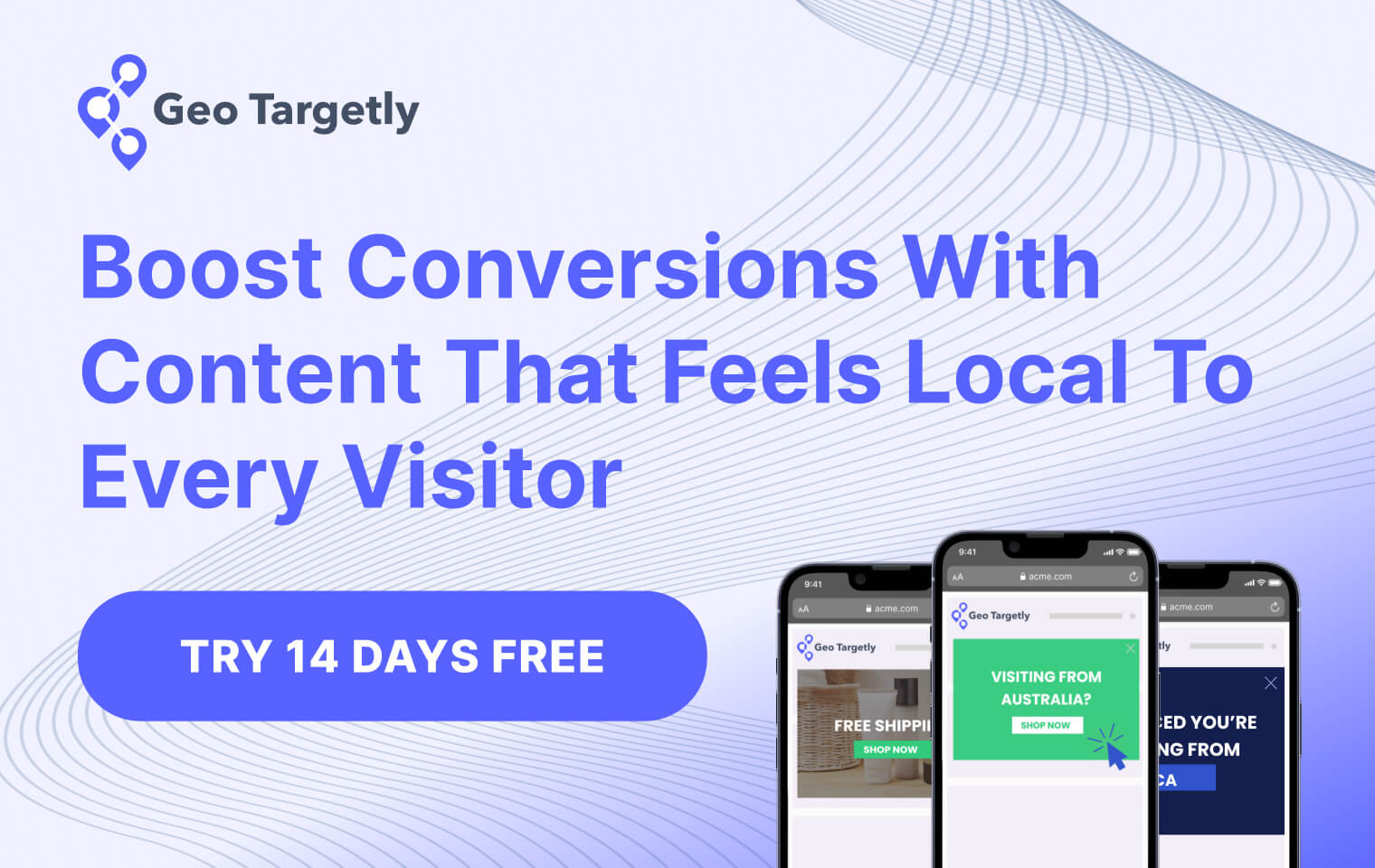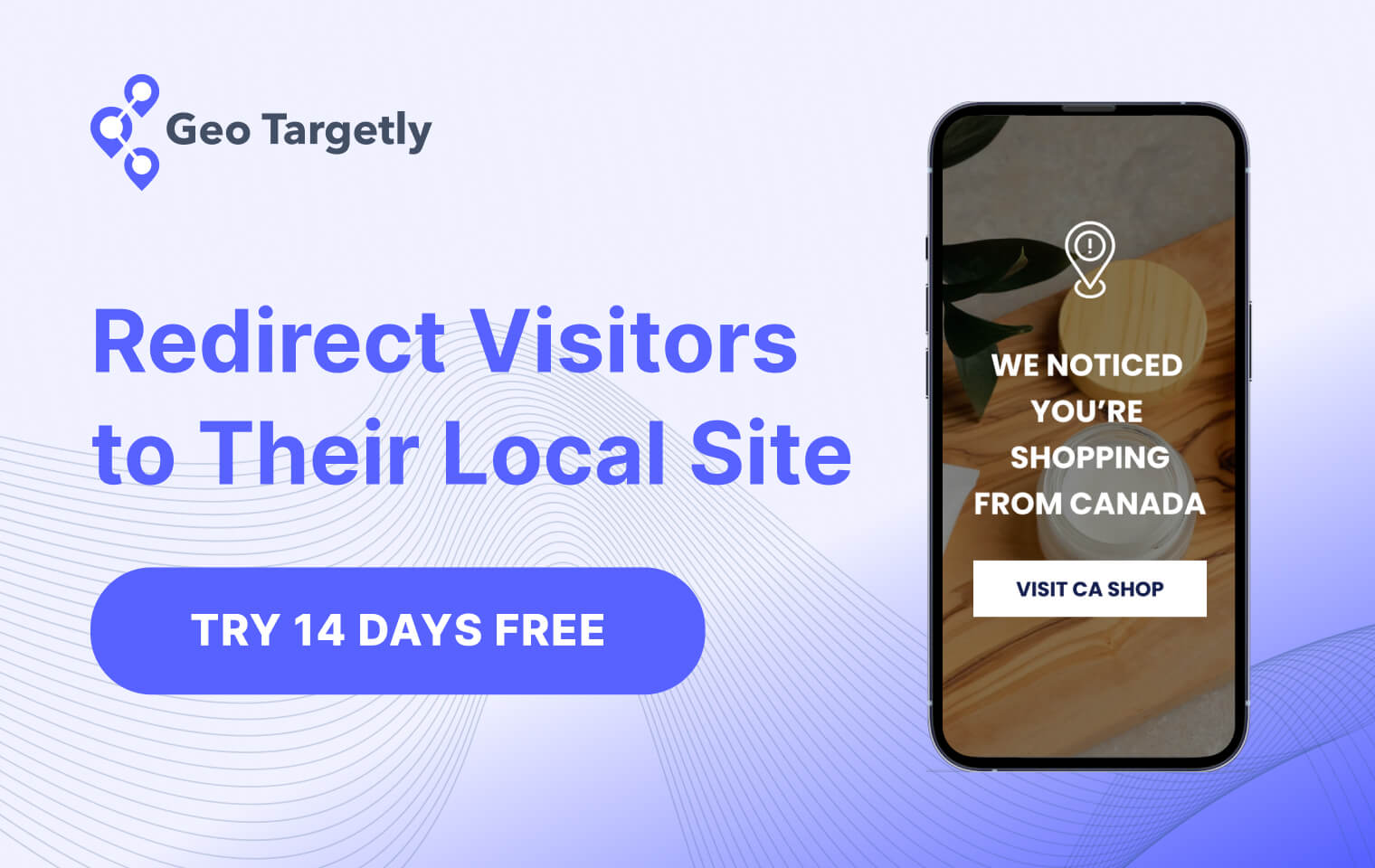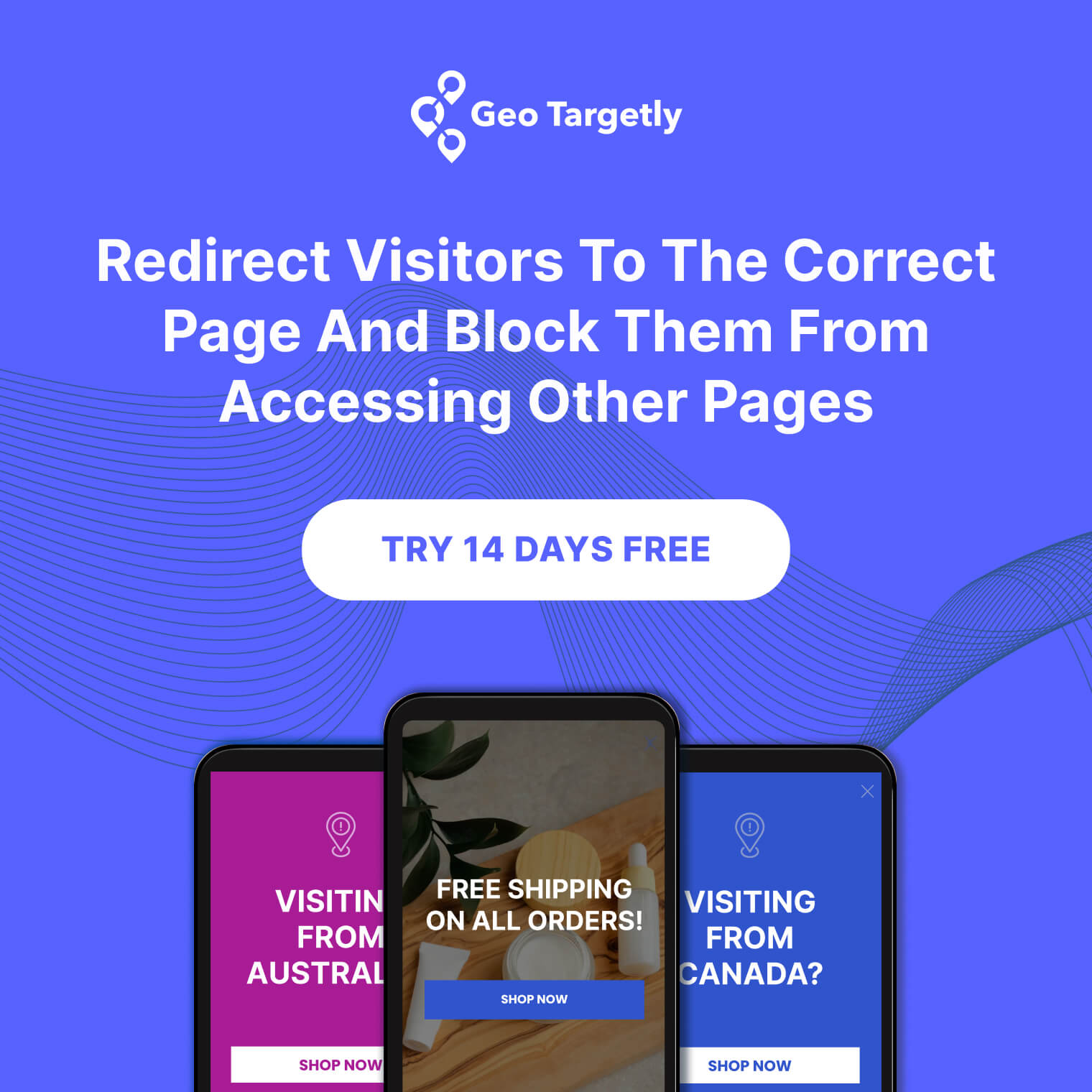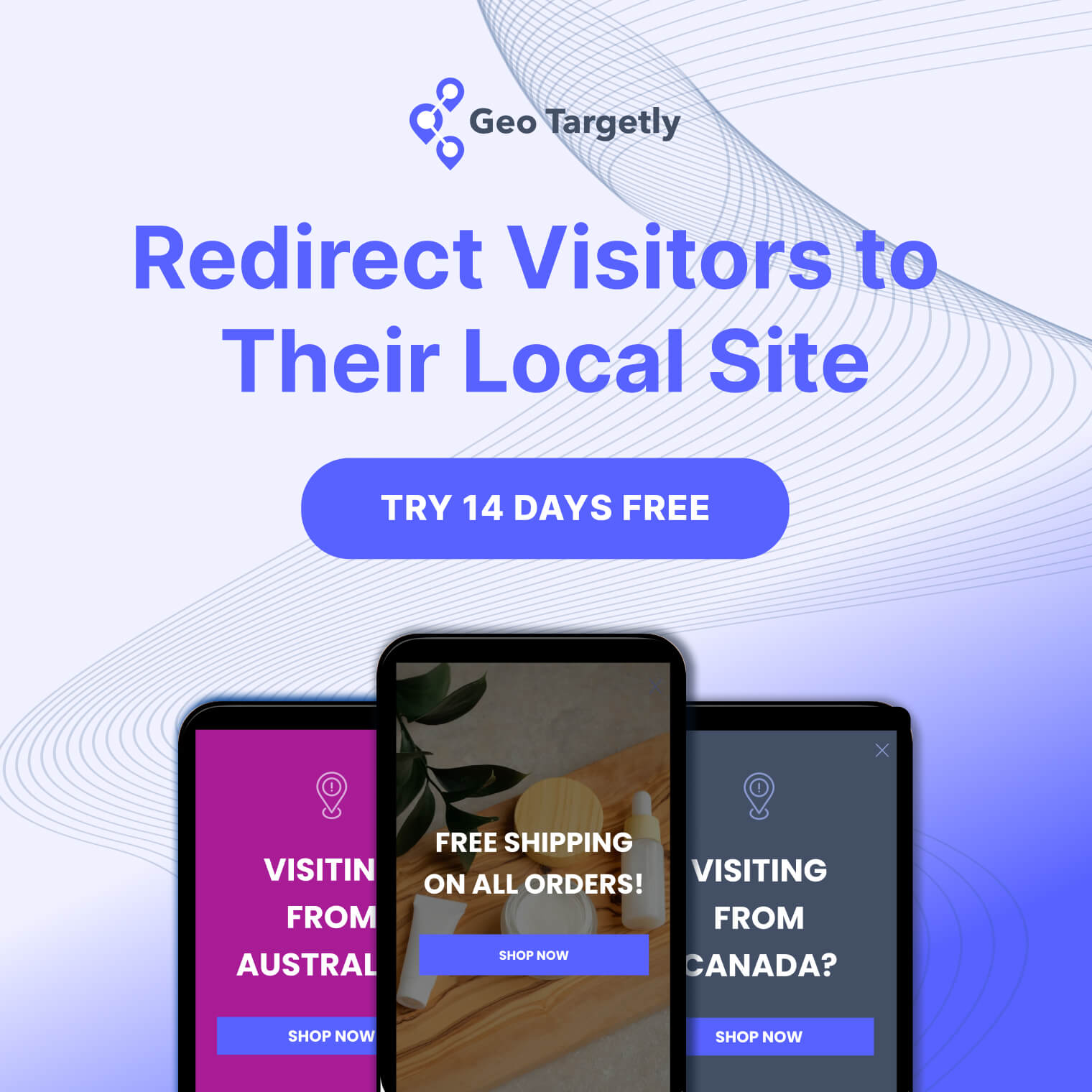
Key takeaways:
- Shopify can get expensive fast due to extra app costs and transaction fees if you don’t use Shopify Payments.
- Some alternatives, such as Wix, Squarespace, and Square Online, are better for beginners or brick-and-mortar stores.
- WooCommerce, BigCommerce, and Adobe Commerce offer more backend control and better localization for global selling.
- Geo Targetly helps boost international sales by automatically showing the right currency, content, and regional store to each visitor.
- Migrating from Shopify takes planning, especially to protect your SEO and replace critical app functions.
Shopify is one of the biggest names in e-commerce, but it’s not always the best fit for everyone. Maybe you’re frustrated by rising monthly fees, tired of paying extra for basic features through third-party apps. Or maybe you’re hitting limits with customization, localization, or scaling your business internationally. There’s always an alternative option for you.
In this guide, we’ll break down the 12 best Shopify alternatives of 2025. Whether you’re a first-time store owner, a growing brand, or a developer building something custom, we’ve got you covered. We’ll compare features and ideal use cases so you can choose the platform that fits your business (and budget).
Why look for a Shopify alternative?
Shopify’s market share shows how popular it is, but popularity doesn’t mean it’s the best choice for every store. Many businesses explore alternatives for the following reasons:
- Rising total cost of ownership. Shopify’s monthly fees range from $39 to $399, but real costs are often higher once you add paid themes, essential apps, and third-party integrations. For many stores, apps alone can exceed the base subscription.
- Limited backend control. Shopify’s hosted setup gives you stability and security, but developers have no direct access to server-side code. Advanced changes require workarounds or custom apps, which can slow development and raise costs.
- Transaction fees without Shopify Payments. If you use an external payment gateway, Shopify typically charges an extra 0.5% to 2% on each sale. Over time, this can be a significant expense for high-volume stores.
- Weak native localization features. Shopify supports multiple languages and currencies, but without apps, it doesn’t automatically detect visitor location or serve local content. This can hurt conversion rates for international traffic.
- Scaling and flexibility limits. While Shopify Plus offers enterprise features, it’s not always as flexible as platforms designed for headless commerce or API-first architectures. Businesses with complex product data or multi-store setups often need more control.
- Mismatch with specific use cases. Service providers, B2B companies, or stores with unconventional product structures may find Shopify’s product and checkout model too rigid.

Quick comparison table of Shopify competitors
Below is a side-by-side snapshot of the top Shopify alternatives in 2025, showing their best use cases, starting prices, standout features, and potential drawbacks.
Note: Prices are subject to change and may vary by billing cycle and region. Visit each pricing page for the most accurate and up-to-date pricing.
Shopify alternatives by use case
The best Shopify alternative for you depends heavily on your business model, technical comfort, and growth goals. To make the decision easier, we’ve grouped the top platforms by their ideal use cases, starting with beginner-friendly and budget-conscious options.
1. For beginners and low-budget stores
If you’re launching your first e-commerce site or working with a lean budget, you need a platform that’s easy to set up, affordable, and packed with core features without overwhelming complexity. Here are the top contenders:
- Wix
- Square Online
- Hostinger Website Builder
- Squarespace
Wix
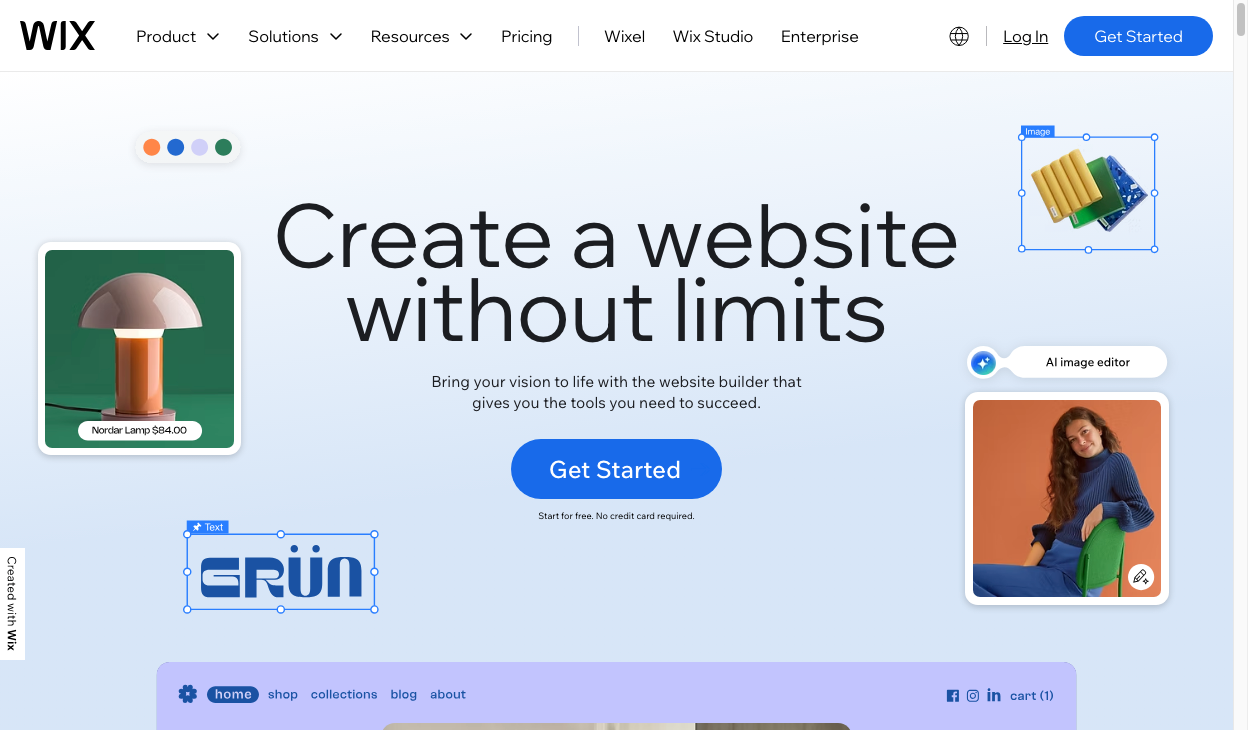
Wix has evolved from a simple drag-and-drop website builder into one of the most beginner-friendly ecommerce platforms in 2025. It’s well-suited for solo entrepreneurs, side-hustlers, and small businesses that want to get online fast without diving into code or complex setup.
Its AI Site Generator can build a branded storefront in minutes, complete with product pages, a functioning checkout, and core marketing tools baked in. With over 900 designer-made templates, it offers more design freedom out of the box than Shopify, while integrating native features like email marketing and SEO settings that Shopify often leaves to third-party apps.
That said, Wix is better for those who value simplicity, visual control, and lower startup costs over advanced inventory management.
Standout features
- AI-powered store setup: Automatically generates layouts, product pages, and branding elements based on your inputs.
- 900+ customizable templates: Far more variety than Shopify’s 13 free themes, covering niche industries.
- Built-in marketing tools: Email campaigns, abandoned cart recovery, and basic SEO are built into the dashboard.
- Multi-currency and global payments. Simple configuration for international selling without complex app setups.
How Wix compares to Shopify
- Pricing advantage: Wix starts at $17/month with no extra app costs for basic marketing tools, making it cheaper for startups.
- Design freedom: More visual control and template variety without touching code.
- Where Shopify Wins: Shopify still leads for advanced ecommerce features like large inventory management, fulfillment integrations, and an expansive app ecosystem.
- Bottom line: Choose Wix if speed, design flexibility, and affordability matter more than enterprise-level selling features.
Square Online
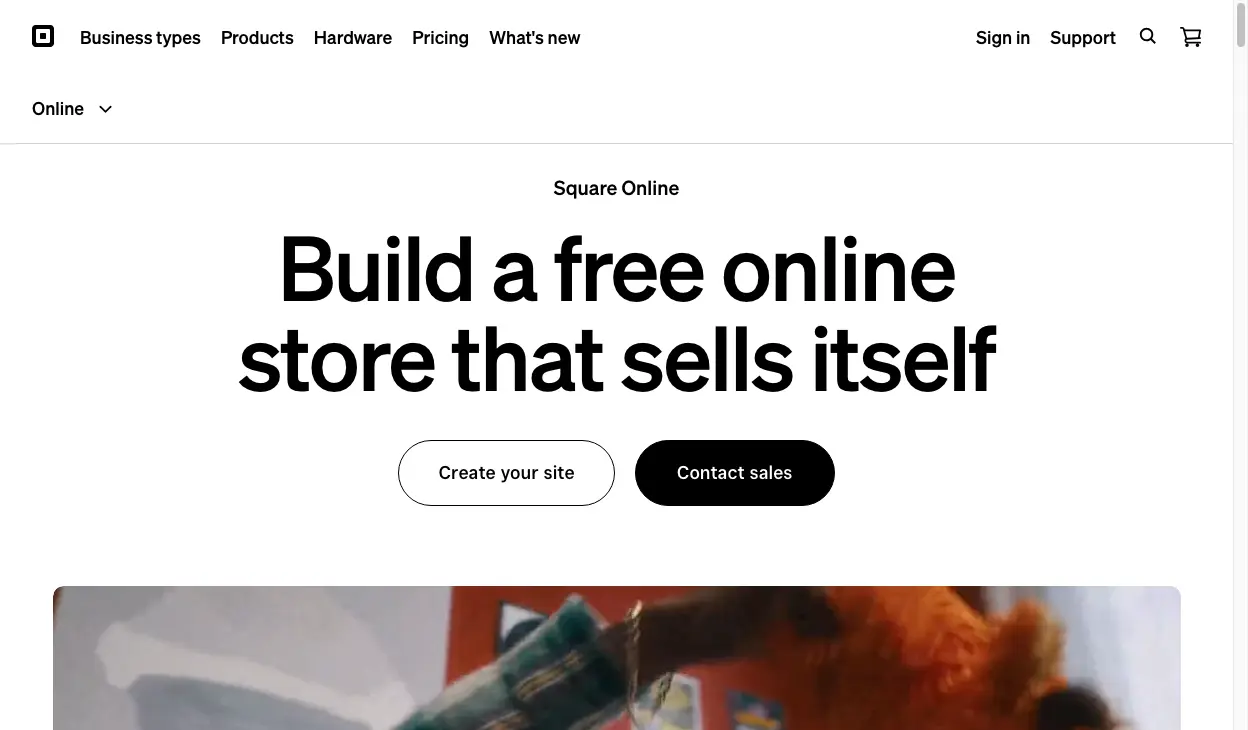
Square Online is designed for merchants who sell both online and in physical stores. It comes with built-in point of sale (POS) integration and uses the same payment system as Square’s in-person hardware. This keeps inventory, sales, and customer data synced in real time.
Getting started is quick: choose a template, add your products, and link your Square account. There’s no extra fee for POS access, and the free plan allows you to start selling right away while only paying standard processing fees.
Compared to Shopify, Square Online has fewer design options and a smaller app ecosystem. It also lacks some advanced automation and customization tools. Still, for hybrid sellers who value speed, simplicity, and unified POS, it’s one of the most practical choices.
Standout features
- Native POS sync: Real-time inventory updates across in-person and online sales.
- Free e-commerce plan: Launch without a monthly subscription.
- Simple product catalog management: Add, update, or remove items from the same dashboard used for your physical store.
- Integrated fulfillment options: Supports shipping, local delivery, and in-store pickup without extra plugins.
How Square Online compares to Shopify
- Pricing advantage: Free plan available; even paid plans bundle POS without extra subscription costs, making hybrid selling cheaper.
- POS integration: Native in-person and online sales sync without add-ons, ideal for physical retailers.
- Where Shopify wins: Broader theme selection, more app integrations, and stronger international selling tools.
- Bottom line: Pick Square Online if you already use Square POS or need a unified online/offline system at minimal cost.
Hostinger Website Builder
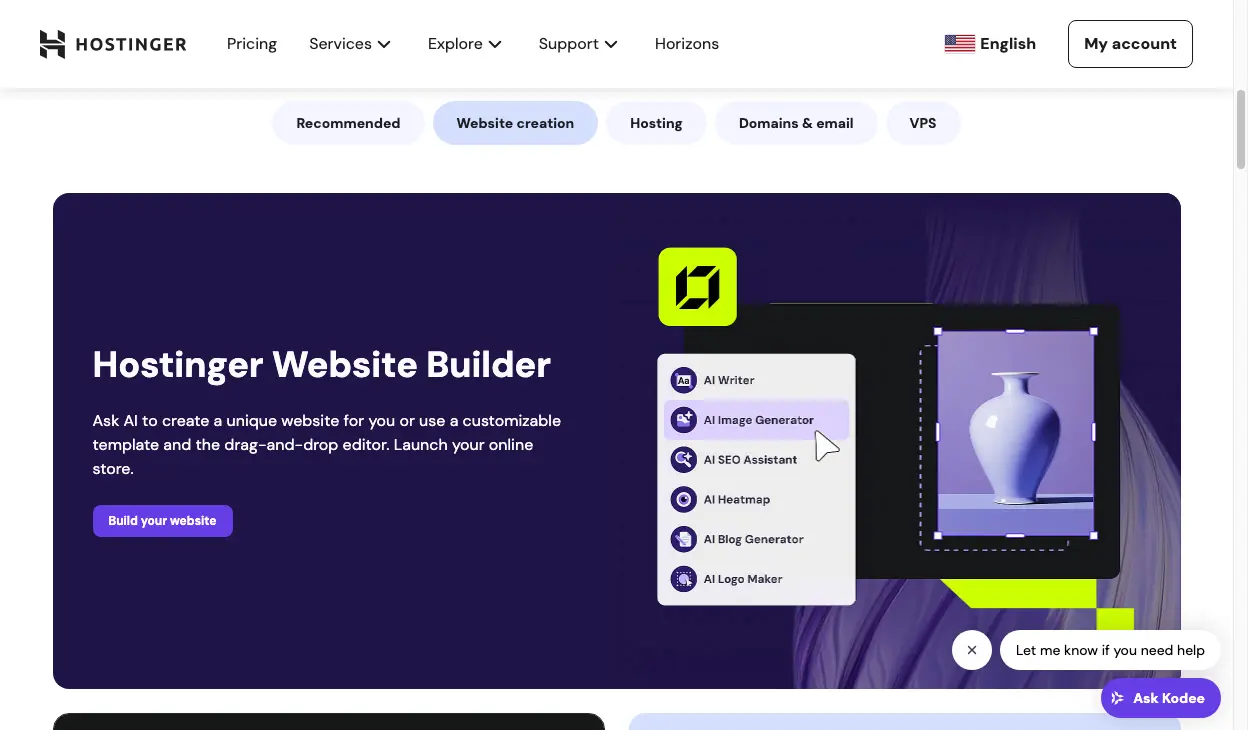
Hostinger Website Builder is aimed at budget-conscious entrepreneurs who want to launch an online store with minimal investment. It combines hosting, SSL, and a drag-and-drop builder in one package. This eliminates the need for separate service subscriptions.
Its AI tools can generate layouts, product descriptions, and even branding elements. While it supports e-commerce, blogging, and basic marketing integrations, it’s best suited for smaller catalogs or early-stage businesses.
Compared to Shopify, Hostinger sacrifices app variety and deep automation features but offers unmatched affordability for the essentials.
Standout features
- Bundled hosting and SSL certificate: Hosting, SSL, and domain management are included, so there’s no separate infrastructure setup.
- AI site and content generator: Automatically creates layouts and starter copy to speed up store launch.
- Ecommerce functionality included: Built-in store features for product listings, payments, and shipping; can integrate with more advanced tools if you upgrade later.
- Integrated analytics and marketing tools: Basic traffic reports, SEO settings, and email marketing features without relying on extra plugins.
How Hostinger Website Builder compares to Shopify
- Pricing advantage: Starts at just $2.99/month with hosting, SSL, and builder included, which is lower than Shopify’s entry tier.
- Ease of launch: AI-driven site setup and bundled services make going live quick and hassle-free.
- Where Shopify Wins: Larger app ecosystem, deeper automation, and advanced inventory features.
- Bottom line: Ideal for testing an e-commerce idea or running a small store on a tight budget, with an upgrade path via WooCommerce.
Squarespace

Squarespace is a design-focused website builder that also offers e-commerce tools, making it a strong option for small businesses and creatives.
Unlike Square Online, which is built around payments and POS integration for local stores, Squarespace is built for polished, design-led websites with e-commerce as part of the package. It’s best for merchants who want an elegant storefront and an all-in-one platform without relying on extra apps or plugins.
Standout features
- Designer templates: Sleek, mobile-optimized themes built for creative industries.
- Built-in marketing: Email campaigns, social posting, and SEO tools included.
- Multi-product support: Sell physical, digital, or service-based products in one place.
- Scheduling integration: Native booking and appointment features for service providers.
How Squarespace compares to Shopify
- Pricing advantage: Starts at $16/month, cheaper than Shopify Basic.
- Design strength: Templates are more polished out of the box.
- Where Shopify wins: Larger app ecosystem and stronger fulfillment tools.
Bottom line: Choose Squarespace if you want a simple, professional store that’s easy to set up and manage without extra complexity.
2. For WordPress power users
If you’re building on WordPress or want full control over your store’s design and backend, these platforms offer unmatched flexibility and ownership. They require more setup than hosted solutions, but reward you with complete customization.
Here are the top contenders:
- WooCommerce
- Easy Digital Downloads (for digital products)
WooCommerce
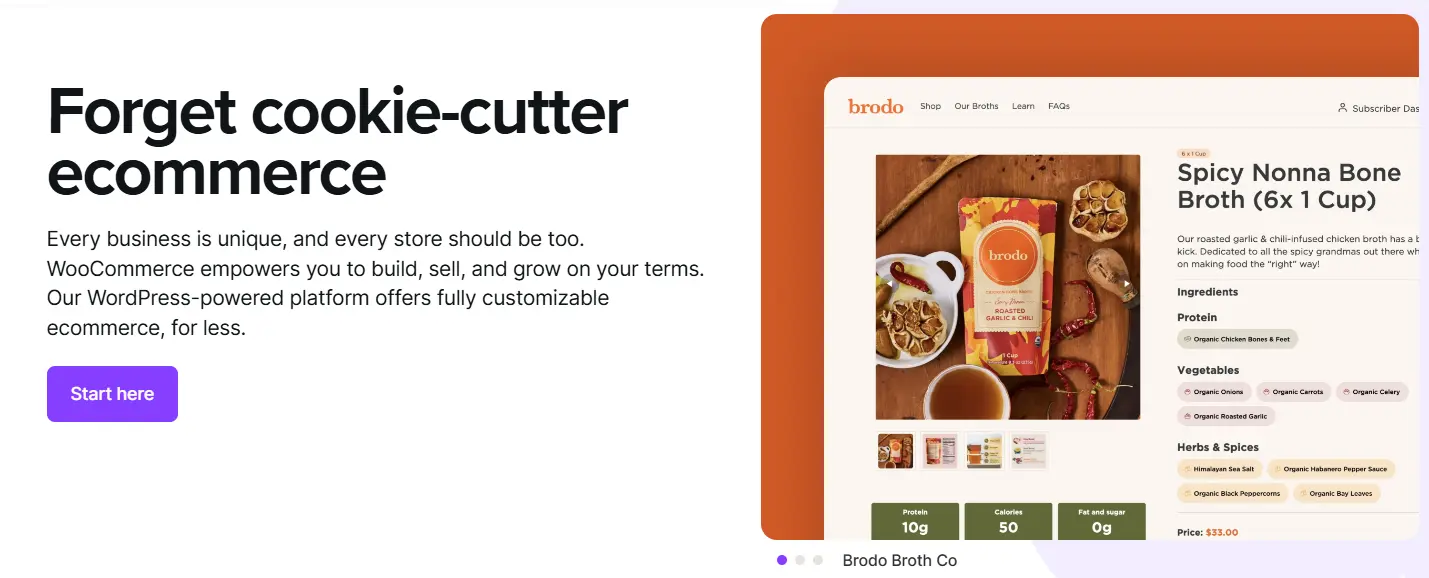
WooCommerce is the go-to e-commerce solution for WordPress site owners who want complete control over their store’s design, functionality, and hosting environment. It’s a free, open-source plugin that turns any WordPress site into a fully functional online store.
Its library of themes, plugins, and integrations can build anything from a simple storefront to a complex, multi-channel retail system. While this level of customization is a major advantage, it comes with a steeper learning curve. You’ll need to handle hosting, security, and maintenance yourself (or with a managed WordPress host).
For content-driven businesses or brands that want their store deeply integrated with their blog, membership site, or other WordPress features, WooCommerce is often the best fit.
Standout features
- Open-source flexibility: Full access to code for custom design, functionality, and integrations.
- Massive plugin ecosystem: Thousands of free and paid extensions for payments, shipping, subscriptions, and more.
- Woo Express: A hosted version that removes the need for a separate hosting setup.
- Woo AI: Intelligent product recommendations, analytics, and automation built into the dashboard.
How WooCommerce compares to Shopify
- Pricing advantage: Core plugin is free; you only pay for hosting and specific extensions you choose.
- Customization depth: Complete design and functional freedom through open-source architecture.
- Where Shopify wins: Turnkey setup, built-in hosting, and unified customer support.
- Bottom line: Best for WordPress-savvy users or businesses that need deep customization and control over their ecommerce stack.
Easy Digital Downloads (EDD)
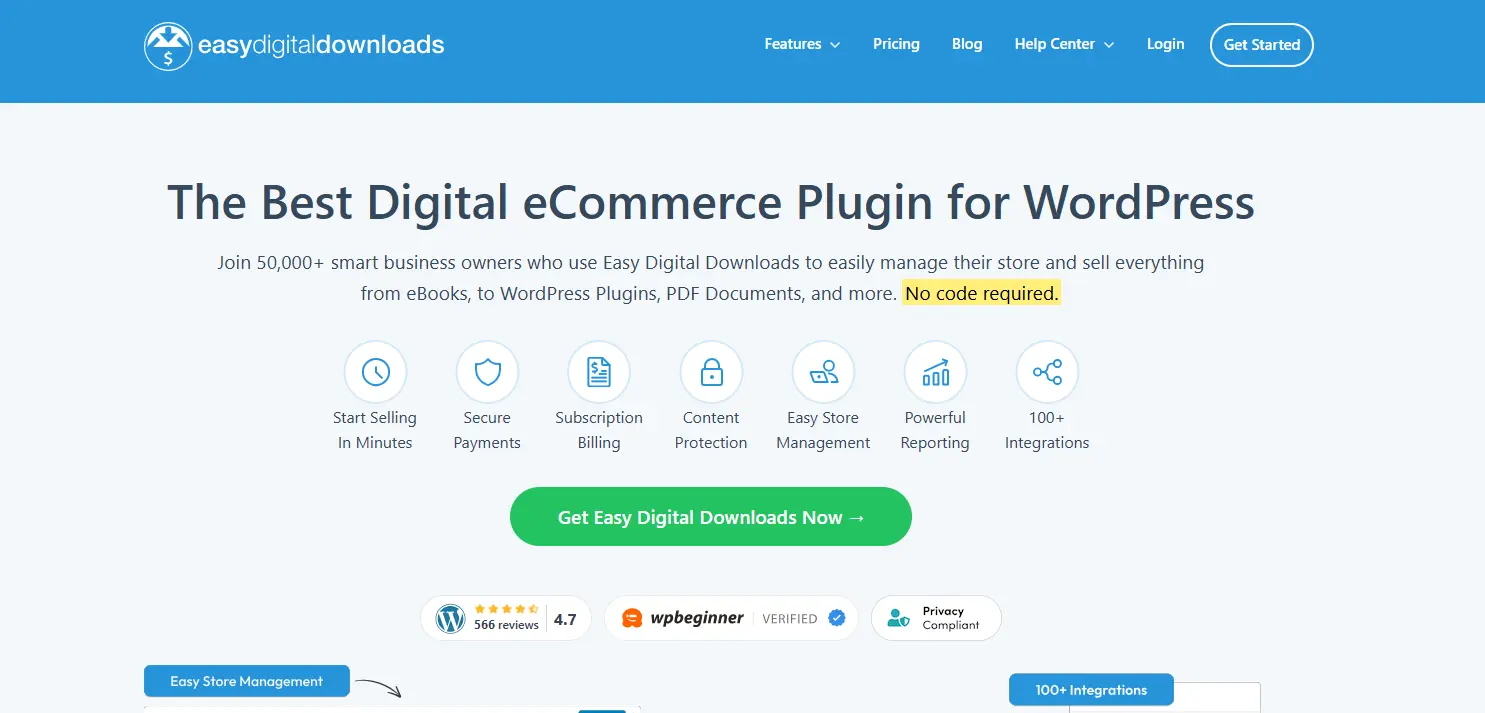
Easy Digital Downloads is a WordPress plugin purpose-built for selling digital goods such as ebooks, software, music, or online courses. While WooCommerce can handle digital products, EDD focuses exclusively on them, stripping away the features you don’t need for physical inventory.
It's a go-to for creators and developers monetizing downloads or recurring content. Compared to Shopify, EDD avoids the extra steps and workarounds required to optimize Shopify for purely digital sales.
Standout features
- Optimized for digital goods: Streamlined checkout process designed for selling files, software, or other downloadable products without shipping steps.
- Software licensing add-on: Manage license keys, deliver software updates, and handle renewals directly from your store.
- Recurring payments: Built-in tools for selling memberships, subscriptions, and payment plans.
- Detailed reporting: Monitor sales, downloads, and customer behavior from a single dashboard.
How EDD compares to Shopify
- Pricing advantage: Free core plugin, with optional paid passes based on the features you need.
- Specialization: Focused entirely on digital goods and has no unnecessary shipping or inventory features.
- Where Shopify Wins: Broader ecosystem for mixed physical/digital sales and multi-channel selling.
Bottom line: Choose EDD if your business revolves around downloadable products and you want a lightweight, WordPress-native solution.
3. For high-growth or enterprise needs
If your store is scaling fast or you’re managing a high-volume, multi-channel operation, you’ll need more than beginner-friendly features. These platforms are designed for advanced selling, complex product catalogs, and enterprise-grade workflows, without relying heavily on third-party add-ons. Here are the top contenders:
- BigCommerce
- Adobe Commerce (Magento)
- Shift4Shop
BigCommerce
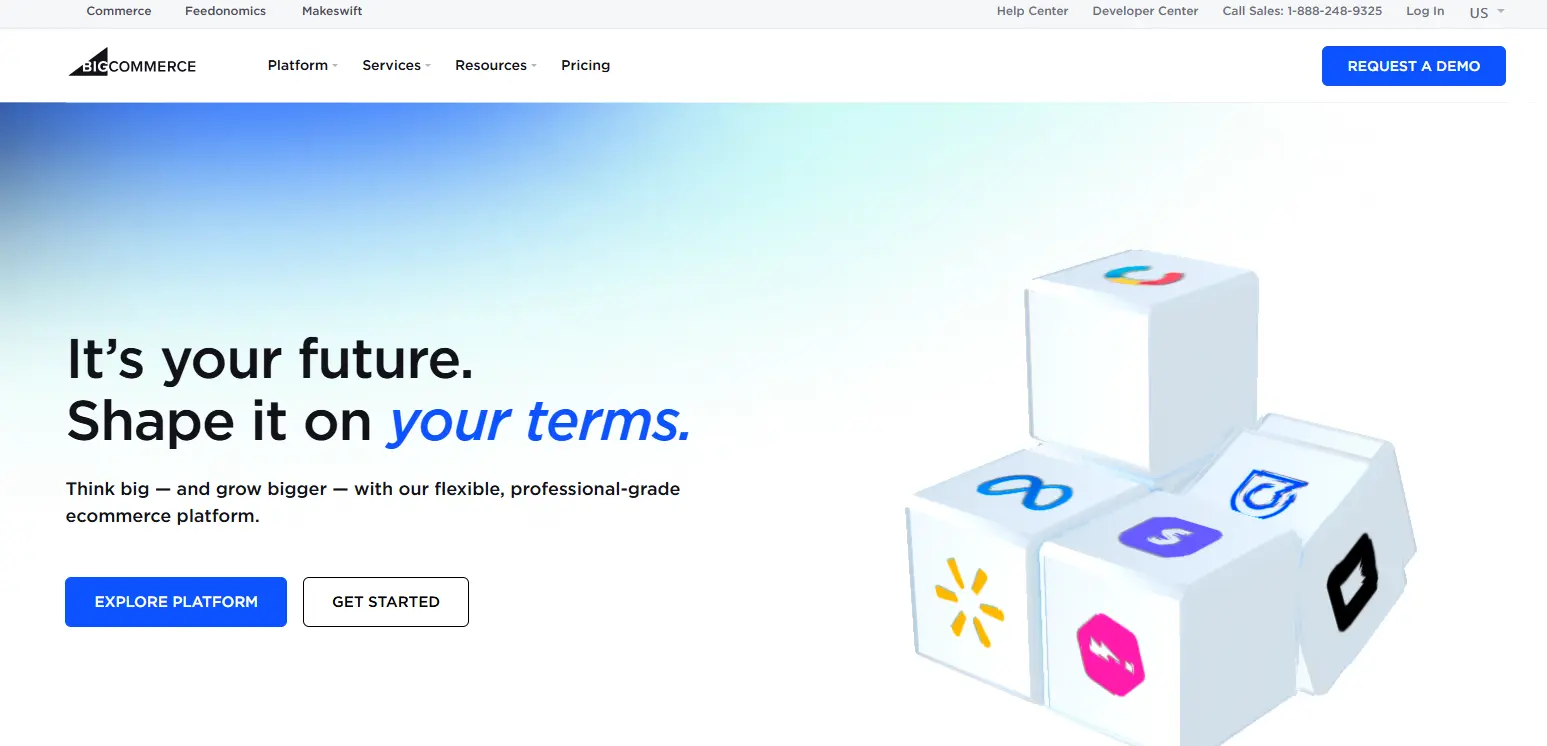
BigCommerce is a cloud-based e-commerce platform built for serious growth. It’s especially popular with mid-market and enterprise merchants thanks to its native toolset.
It’s also one of the few platforms with no transaction fees on any plan. This makes it attractive for high-volume sellers. While Shopify offers a sleeker UI and larger theme library, BigCommerce shines in scalability and reducing reliance on paid apps.
Standout features
- No transaction fees: Keep more of your revenue regardless of the payment processor.
- Native B2B tools: Custom pricing, customer groups, and quote management without third-party add-ons.
- Multi-storefront management: Run multiple brands or regional sites from a single backend.
- Headless-ready architecture: Supports composable commerce for API-first builds.
How BigCommerce compares to Shopify
- Pricing advantage: No transaction fees, plus fewer paid apps needed for core features.
- Feature depth: Built-in B2B, multi-currency, and multi-storefront tools.
- Where Shopify Wins: More polished onboarding, larger theme marketplace, broader app ecosystem.
- Bottom line: Best for scaling brands that want enterprise-level capabilities without a patchwork of third-party solutions.
Adobe Commerce (Magento)
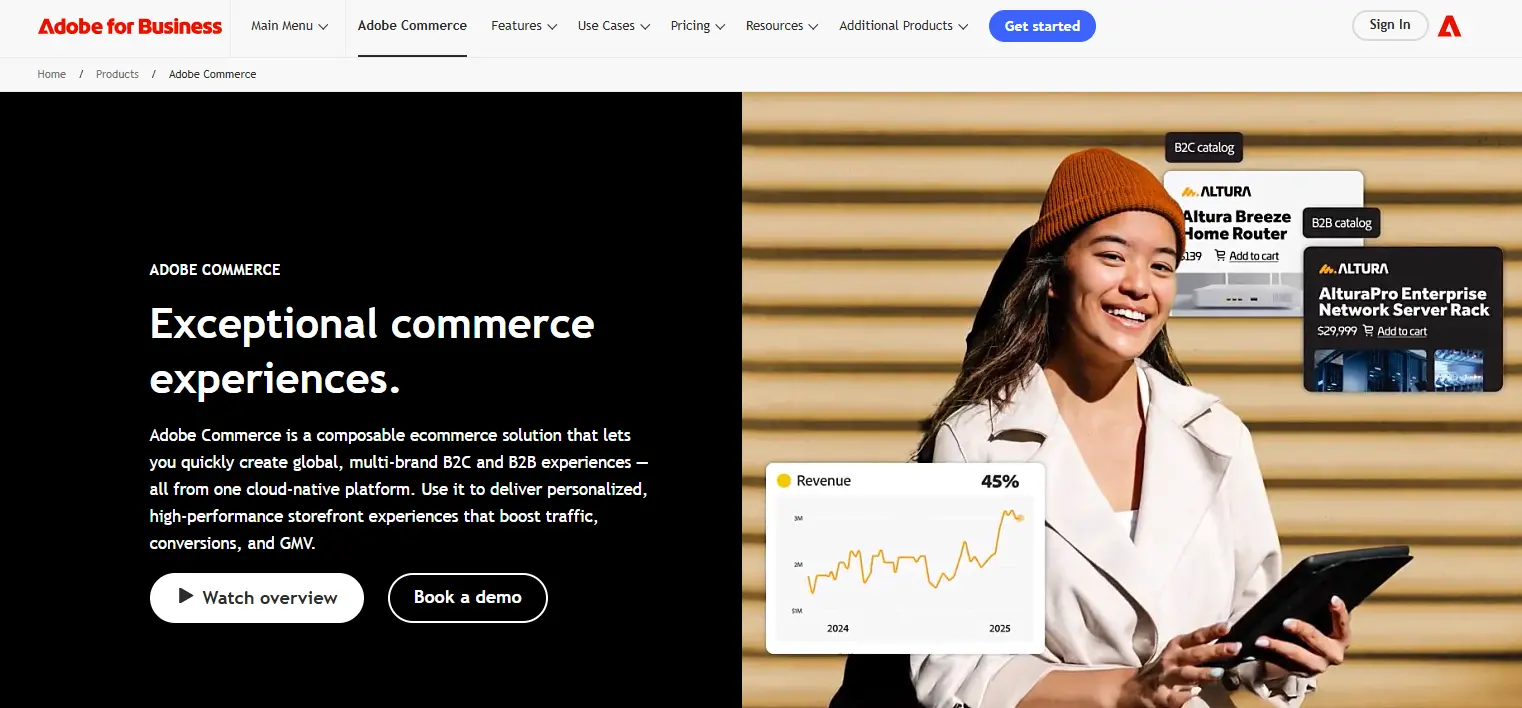
Adobe Commerce, formerly Magento, is an open-source e-commerce platform built for large-scale, highly customized online stores. It’s favored by enterprises and complex B2B operations that need full control over every aspect of their e-commerce infrastructure.
Unlike Shopify or BigCommerce, Adobe Commerce requires dedicated development resources, but in exchange, it offers flexibility, security, and integration options that can be tailored to unique business requirements. For global, multi-brand retailers, it’s one of the most future-proof choices on the market.
Standout features
- Enterprise-level customization: Full code access with powerful theming and extension support.
- Advanced B2B suite: Includes custom catalogs, quote requests, and account hierarchies.
- Scalable architecture: Handles high traffic volumes and complex product catalogs with ease.
- Seamless Adobe integration: Connects with Adobe’s marketing, analytics, and content tools.
How Adobe Commerce Compares to Shopify
- Customization depth: Far more flexible than Shopify, with complete backend control.
- Enterprise readiness: Handles complex B2B workflows and massive catalogs without heavy reliance on third-party apps.
- Where Shopify Wins: Lower barrier to entry, faster launch times, and simpler maintenance.
- Bottom line: Choose Adobe Commerce if you have the budget, technical team, and need for a fully tailored, enterprise-grade ecommerce solution.
Shift4Shop
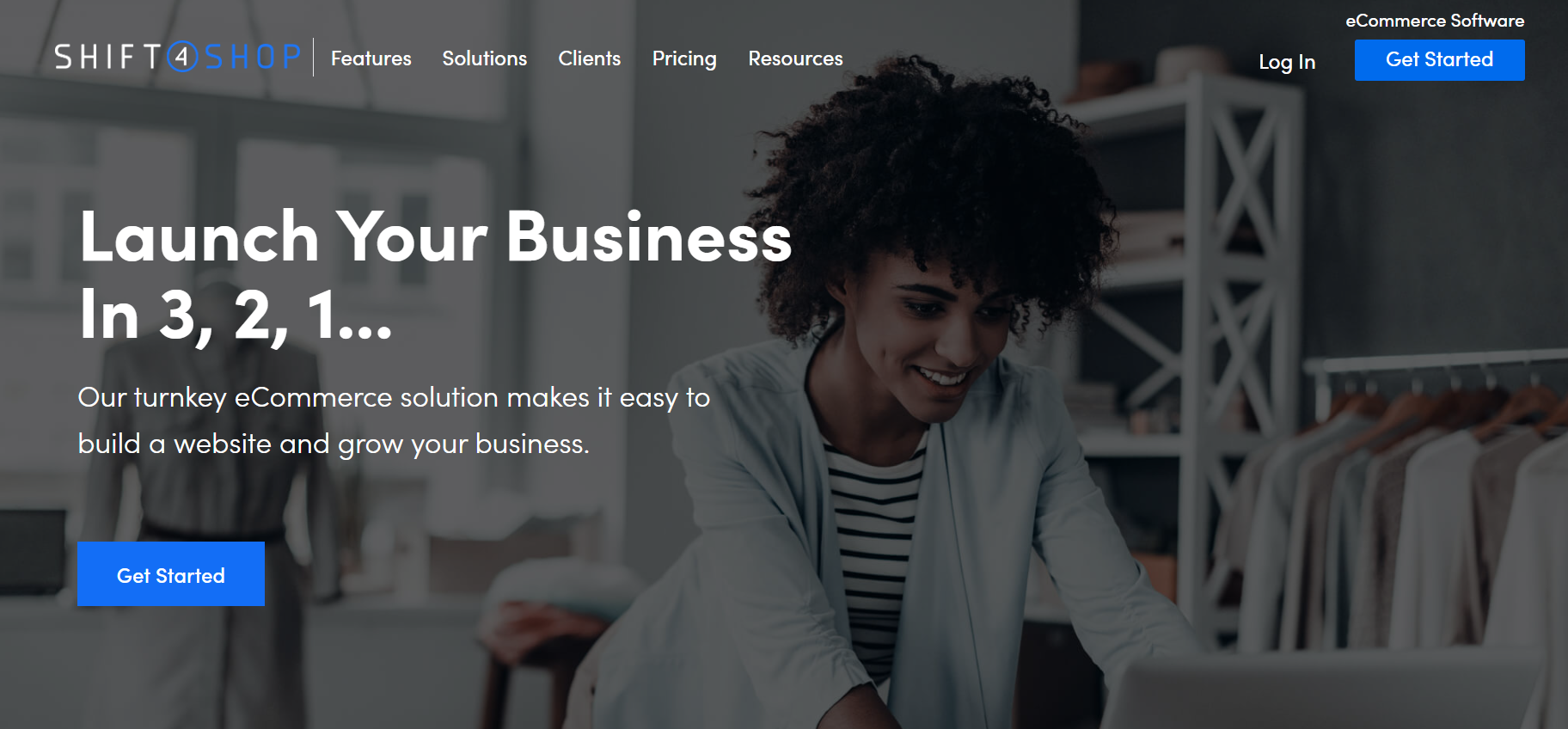
Shift4Shop, formerly 3dcart, is a full-featured e-commerce platform designed for value. It includes unlimited products, built-in SEO tools, and blogging at no extra cost. For U.S. merchants using Shift4 payments, the platform is free, making it a practical choice for small to mid-sized businesses preparing to scale.
Standout features
- Unlimited products & storage: Sell without restrictions or forced plan upgrades.
- Advanced SEO: Built-in features for clean URLs, schema, and metadata.
- Integrated blog: Content and commerce managed in one backend.
- Free for U.S. merchants: No monthly fee when using Shift4 as your payment processor.
How Shift4Shop compares to Shopify
- Pricing advantage: No subscription cost with Shift4 payments.
- Feature depth: SEO, products, and content included out of the box.
- Where Shopify wins: More polished UI, broader app marketplace, and stronger global reach.
Bottom line: Pick Shift4Shop if you want a cost-effective platform with advanced features included, especially if you’re a U.S. merchant.
4. For API-first / headless architecture
If you want maximum flexibility over your storefront experience, an API-first (headless) e-commerce platform may be the way to go. These solutions separate your backend from your frontend, letting you deliver fast, highly customized shopping experiences across websites, apps, and even IoT devices, all powered by the same ecommerce engine.
Here are the top contenders:
- commercetools
- BigCommerce Headless
- Shopify Hydrogen
commercetools
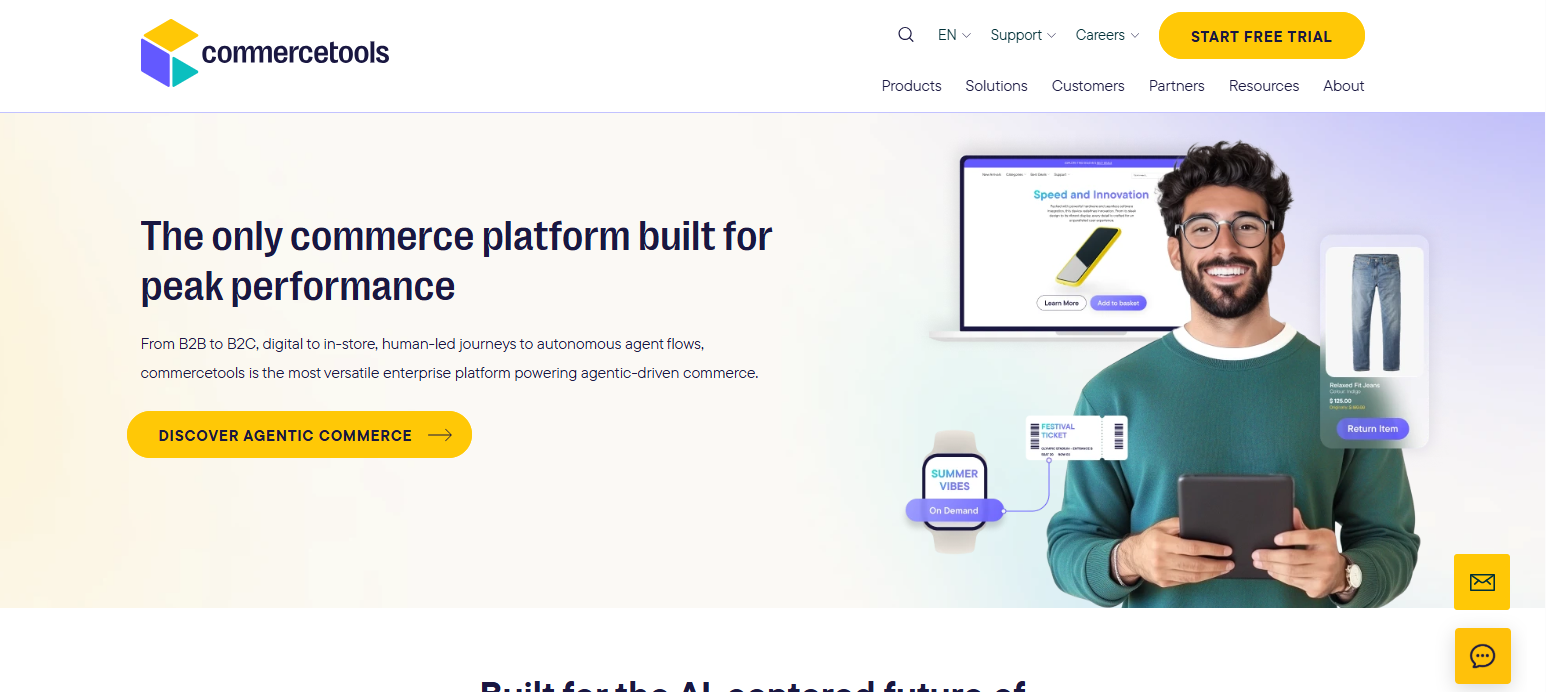
Commercetools is a cloud-native, API-first platform built for brands that want full freedom in how they design, build, and deliver e-commerce experiences. Instead of a predefined storefront, it provides a set of composable services for products, carts, payments, and more.
It’s aimed at enterprise retailers, D2C brands, and global companies that need speed, scalability, and the ability to adapt quickly. Compared to Shopify, commercetools offers far more architectural flexibility but requires significantly more development resources to implement.
Standout features
- Headless by design: No monolithic templates; integrate into any frontend framework.
- Composable architecture: You can pick and choose microservices for your exact needs.
- Global scalability: Multi-region hosting, multi-language, and multi-currency support.
- Developer-first tools: Robust API documentation, SDKs, and GraphQL support.
How commercetools compares to Shopify
- Customization depth: Allows entirely bespoke shopping experiences across any device or platform.
- Architecture: True headless and composable from the ground up.
- Where Shopify wins: Faster setup, prebuilt themes, and lower entry costs.
- Bottom line: Best for enterprise teams that want full creative control and can invest in a developer-driven, API-first stack.
BigCommerce Headless
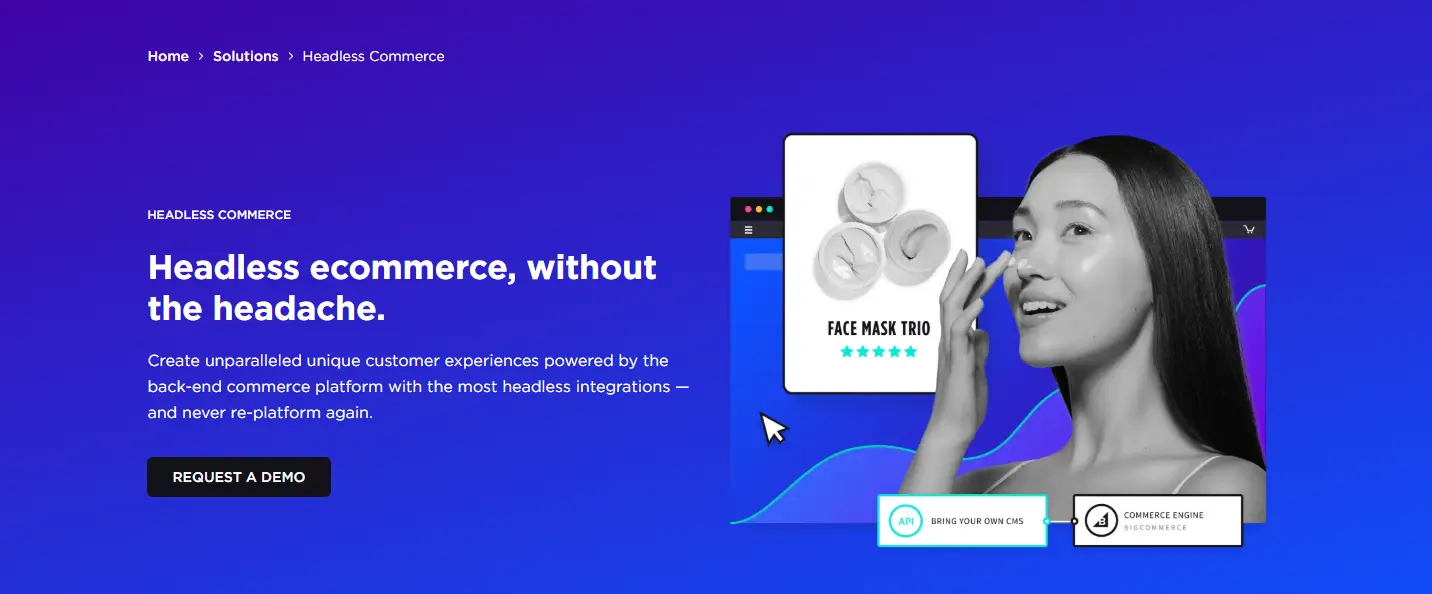
BigCommerce Headless gives you the scalability and feature depth of BigCommerce’s backend while letting you build a completely custom frontend using your preferred framework, such as Next.js, Gatsby, Vue, or others.
It’s ideal for brands that want advanced e-commerce features (B2B tools, multi-storefront, multi-currency) but still need design freedom and performance optimization through a decoupled architecture.
Compared to Shopify’s headless approach, BigCommerce Headless provides more built-in enterprise tools out of the box. You don’t need to have third-party apps, but it retains the same challenge of requiring a skilled development team.
Standout features
- Decoupled architecture: Deliver custom frontends without losing access to BigCommerce’s backend.
- Multi-storefront & multi-channel: Manage multiple brands or regions from one backend.
- Native B2B suite: Customer groups, custom pricing, and quote management.
- GraphQL & REST APIs: Integrate ecommerce into websites, apps, kiosks, and more.
How BigCommerce Headless compares to Shopify
- Pricing advantage: No transaction fees, plus fewer paid apps needed for B2B or multi-storefront.
- Enterprise readiness: More built-in advanced features for complex catalogs and workflows.
- Where Shopify wins: A Larger community of headless developers and prebuilt storefront frameworks (Hydrogen).
- Bottom line: A strong choice for scaling brands that want a hybrid of enterprise features and headless flexibility without excessive app reliance.
Shopify Hydrogen
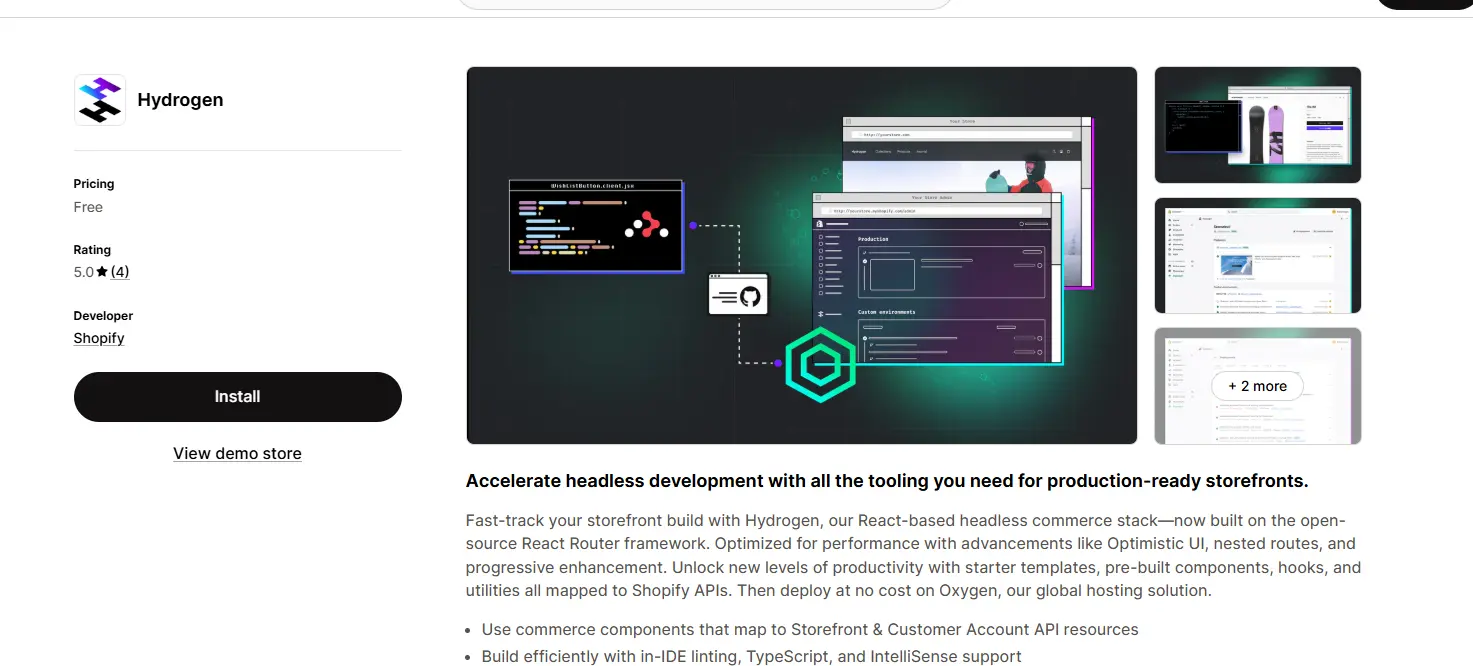
Hydrogen is Shopify’s React-based framework for building custom storefronts on top of Shopify’s backend. It’s Shopify’s official headless solution, designed to give developers more creative control over the storefront experience while still benefiting from Shopify’s powerful commerce engine, security, and app ecosystem.
It’s a natural choice for merchants already on Shopify who want to push beyond theme limitations. However, while it offers faster integration for Shopify data, it’s not as architecture-agnostic as commercetools or BigCommerce Headless, as you’re still tied to Shopify’s infrastructure.
Standout features
- Pre-optimized for Shopify: Built-in hooks and utilities to query products, collections, and checkout.
- React + Vite: Modern development stack for fast, dynamic storefronts.
- Oxygen hosting: Shopify’s hosting environment for Hydrogen projects, optimized for global performance.
- Commerce + content blending: Easy integration with CMSs, custom apps, and third-party APIs.
How Shopify Hydrogen compares to traditional Shopify
- Design flexibility: Removes theme limitations, enabling unique storefront experiences.
- Developer-friendly: Optimized for React with built-in commerce utilities.
- Where traditional Shopify wins: Simpler setup and maintenance, no need for custom hosting or dev resources.
- Bottom line: Ideal for Shopify merchants who want the creative control of headless commerce without leaving the Shopify ecosystem.
Cost comparison: Shopify vs. competitors
When comparing Shopify with other e-commerce platforms, the monthly subscription price is just the starting point. The real cost includes:
- Monthly fees - your base plan.
- App costs - many features require paid add-ons.
- Transaction fees - Shopify charges extra if you don’t use Shopify Payments.
Shopify’s pricing and hidden costs
Shopify’s plans range from $39/month (Basic) to $399/month (Advanced), plus Shopify Plus for enterprises. While the base price seems reasonable, extra apps for subscriptions, SEO, or loyalty programs can add $10–$50/month each. Transaction fees (0.5%–2%) also apply unless you use Shopify Payments, which can add up quickly for higher-volume stores.
Example cost scenarios:
- Startup Store: Shopify Basic ($39/mo) + 3 paid apps ($45/mo) = ~$1,000/year before transaction fees.
- Scaling Store: Shopify Plan ($105/mo) + 5 paid apps ($100/mo) + 1% transaction fee on $500k/year in sales = over $7,000/year.
Some competitors, such as BigCommerce or WooCommerce, include more features in their base plans and don’t charge extra transaction fees, which can mean big savings over time, especially as your business grows.
Cost breakdown: Shopify vs key competitors (estimated first-year TCO)
Note: This table reflects updated monthly pricing and a clearer distinction between platform fees and payment processing fees.
- Shopify looks affordable up front, but app and transaction fees can push costs higher, especially at scale.
- BigCommerce and WooCommerce can be cheaper over time due to fewer paid add-ons and no platform transaction fees.
- Square Online and Wix have low startup costs, but payment processing fees are still a factor for high-volume sellers.
- Adobe Commerce has no license fee for open source, but infrastructure and development make it an enterprise-level investment.
What about geo-personalization and localization?
For e-Commerce brands selling to multiple countries, localization drives conversion. Customers expect to see the right currency, language, and even relevant products the moment they land on your site. If they don’t, you risk creating friction that sends them to a competitor.
Shopify supports multi-currency and multi-language, but its native geolocation capabilities are limited. There’s no automatic redirect to the correct regional store, no built-in dynamic content based on location, and currency or language changes are often manual unless you add paid apps.
By comparison, WooCommerce (with plugins like WPML or Currency Switcher) and BigCommerce (with built-in multi-currency, multi-language, and multi-storefront tools) make it easier to deliver localized experiences without heavy workarounds.
Localization builds trust, relevance, and confidence in shoppers to buy. That’s where a dedicated solution can bridge the gap.
Use Geo Targetly with your e-commerce stack
Geo Targetly adds advanced location-based personalization to any ecommerce platform, including Shopify, WooCommerce, and BigCommerce. With it, you can:
- Automatically redirect shoppers to the right regional store or page
- Show prices in local currency and adjust content by location
- Personalize banners, promotions, and product visibility by country or city
It works without switching platforms or writing custom code. Geo Targetly runs in the background, helping global visitors feel at home and helping you increase conversions.
No matter what platform you choose, if your customers come from multiple countries, Geo Targetly can help localize the experience and increase conversions.
Migrating from Shopify: What you need to know
Switching from Shopify to another e-commerce platform can unlock new features, lower costs, or provide better scalability. A smooth migration requires careful planning to avoid losing critical data, SEO rankings, or functionality your store relies on. Here’s what to consider:
- Data exports. Shopify allows you to export key data such as products, customers, and orders via CSV files. This ensures your catalog and order history can be imported into your new platform. However, you may need to reformat data depending on the destination platform’s requirements.
- SEO challenges. Changing platforms often means changing URLs. Without proper 301 redirects, you risk losing organic traffic and search rankings. It’s also important to migrate metadata (titles, descriptions) and structured data to maintain your SEO performance.
- Replacing apps and custom features. Many Shopify apps don’t directly transfer to other platforms. Before migrating, identify your mission-critical features, such as subscriptions, loyalty programs, or advanced analytics and find equivalent solutions on your new platform.
- Cost and time considerations. Migration costs vary depending on store size, complexity, and whether you hire an agency. Small stores may migrate in a few days; larger or highly customized stores can take weeks. Budget for potential downtime, data cleaning, and staff training on the new platform.
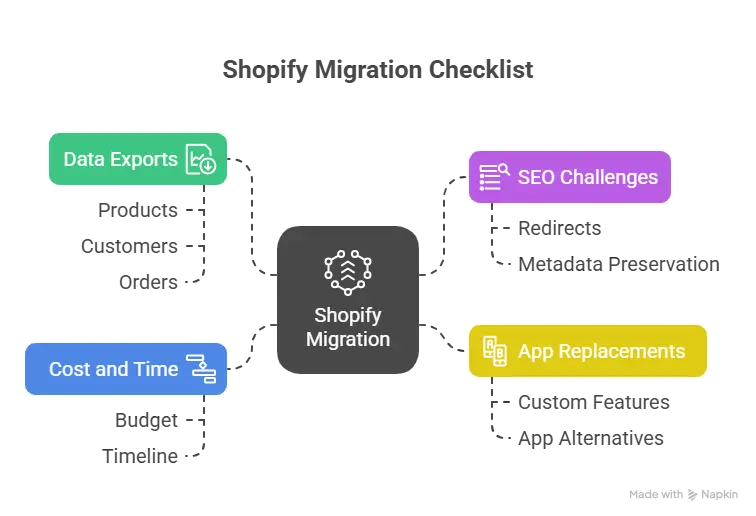
Platform innovation: Who’s building for the future?
The future of ecommerce depends on which platforms are investing in innovation. Shopify, Wix, and WordPress are pushing AI tools that automate store setup, product descriptions, and marketing. Also, BigCommerce, Shopify Hydrogen, and commercetools are advancing headless commerce with strong API support for custom frontends and multi-channel selling.
Community strength also matters: Shopify’s app marketplace, WooCommerce’s WordPress ecosystem, and Adobe Commerce’s developer base ensure continuous growth and solutions.
Choosing a platform isn’t only about current features; it’s about whether the provider is building AI, headless flexibility, and an active ecosystem to keep your store competitive over the next 3–5 years.
Final verdict: Which Shopify competitor is right for you?
When choosing a Shopify alternative, it depends on your stage and goals. If you’re starting small, Wix or Square Online can help you launch fast without high costs.
If you’re growing, BigCommerce or Adobe Commerce gives you stronger tools for bigger catalogs and advanced workflows.
If you want full control, headless options like commercetools or Shopify Hydrogen let you build faster, custom experiences across web, mobile, and more.
Don’t stop at picking a platform. Think about how you’ll reach and convert customers in every market. That’s where Geo Targetly comes in. It lets you show the right currency, content, and offers to every visitor automatically. This helps reduce friction, build trust, and lift sales. Explore our resources and tools to see how we can help you take the next step in growing your store.
FAQs
What’s the cheapest Shopify alternative?
Wix Business Basic starts at about $16/month with hosting, SSL, SEO, and marketing tools included. Square Online has a free plan where you only pay transaction fees, making it ideal for testing before committing to a monthly plan.
Can I switch from Shopify without losing SEO?
Yes, but you need 301 redirects from old URLs to new ones. Also, move your titles, descriptions, alt text, and structured data. Many run both sites briefly to test before fully switching.
Which Shopify alternative is best for international stores?
BigCommerce offers built-in multi-currency, multi-language, and multi-storefront features. WooCommerce with plugins like WPML also works well. For advanced location-based targeting, Geo Targetly adds automatic redirects, local pricing, and personalized content.
Does Shopify allow headless commerce?
Yes. Shopify has Storefront API and Hydrogen for custom storefronts. For more flexible, platform-agnostic headless builds, look at commercetools or BigCommerce Headless.






